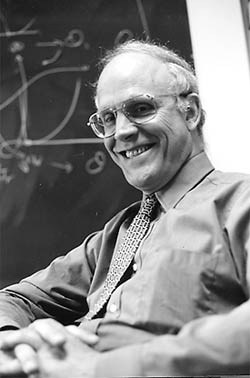UC Berkeley Web Feature
Cal alum David Gross (PhD '66) shares Nobel Prize in Physics
 David Gross (Kurt Rhody photo) |
BERKELEY – The Nobel Prize in Physics went to scientists at UC Santa Barbara, Caltech and MIT today, but at least one UC Berkeley professor is glowing with pleasure at the choice of Cal alum David J. Gross.
"It's absolutely tremendous. I'm basking in reflected glory," said Geoffrey Chew, former chair of the physics department and Gross's advisor when he was a graduate student in the department in the 1960s. Gross, who obtained his PhD in physics in 1966, currently is a professor of physics and director of the Kavli Institute for Theoretical Physics at UC Santa Barbara.
"David was probably the most talented graduate student that I had, and I had a huge number of graduate students," said Chew, now retired from the faculty but still active in elementary particle theory. "He was recognized as a graduate student as having extraordinary talent."
That talent took him to Princeton University, where he and then-graduate student Frank Wilczek came up with a way to describe the "strong force" that governs interactions between protons and neutrons in the nucleus of the atom. He and Wilczek published their proposal simultaneously with H. David Politzer, a graduate student who independently came up with the same idea. Both Wilczek, currently of the Massachusetts Institute of Technology, and Politzer, now of the California Institute of Technology, share the prize with Gross.
According to the Royal Swedish Academy of Sciences, their "discovery was expressed in 1973 in an elegant mathematical framework that led to a completely new theory, quantum chromodynamics." With this discovery, "Gross, Politzer and Wilczek have brought physics one step closer to fulfilling a grand dream, to formulate a unified theory comprising gravity as well - a unified theory for everything."
When the three first proposed their idea, however, Chew admits that he was resistant, primarily because he was approaching the same problem from a different perspective. But he has been won over, as has most of the physics community, if the Nobel Prize is any indication.
"At the time his idea came forth, I was quite skeptical of it, because it was really in a direction quite opposed to my thinking," Chew said. "But there is no doubt that it has had a huge impact on the field, and has led to models that explain a lot of the experimental facts. There is no question of the major nature of that discovery."
The theory of quantum chromodynamics (QCD) is still not the theory of everything, Chew noted. That theory may look totally different from QCD; in fact, many people claim that string theory is closer to being the theory of everything. Chew, who views string theory as a dead end, is currently formulating a unified theory of his own.
The discovery of Gross, Wilczek and Politzer came out of an earlier breakthrough that described electromagnetism, the force that acts between charged particles, such as electrons and protons, and which governs all chemical interactions. That theory, called quantum electrodynamics (QED), won Richard Feynman, Julian Schwinger and Sin-itiro Tomonaga the physics Nobel in 1965.
QED is a way of describing electromagnetic interactions so that predictions can be made and numbers calculated to compare to experiment. Though based on approximations, QED nevertheless allows physicist to predict experimental results to within one part in 100 million. Chew noted, though, that it can get no better than that.
The new Nobelists found a way to extend the methods of QED to describe strong force interactions between the particles that make up protons and neutrons. These theoretical particles - they can never be observed - were dubbed quarks, and the particles that carry the strong force were called gluons. The theory that came out of these initial ideas is called chromodynamics because the quark attribute analogous to the electric charge of an electron or proton is color.
Theorists had thought that the approximation methods of QED would never work with quarks and the strong force because, unlike the electromagnetic force, the strong force increases with distance, preventing quarks from ever being plucked apart and viewed singly. Gross, Wilczek and Politzer found a compromise - a way to describe the interaction but only for quarks so close together that the strong force is small.
"This development that David, Politzer and Wlczek achieved allowed the computational techniques that people had developed in connection with QED in describing atoms to be applied to the nucleus," Chew said. "And although it was not as neat and clean and still isn't as accurate as what was possible with QED, it provided a basis for calculations that were much, much superior to anything that people could do before."
Their approximations accorded very well with the results of high-energy particle experiments that slammed quarks together at very close distances.
"As accelerators got bigger, people were able to do experiments that reached more and more deeply into the interior of the proton, and they got into the region where this funny idea began to be relevant, and sure enough, it started giving correct answers," Chew said. "As time has gone on and accelerators have gotten much bigger, the answers got more and more accurate. It turned out that the idea works better and better the deeper you go inside the nuclear particle."
For further detail on the significance of the research, check the Nobel website or UC Santa Barbara's site. Also listen to the telephone interview with Gross from the Nobel website.

